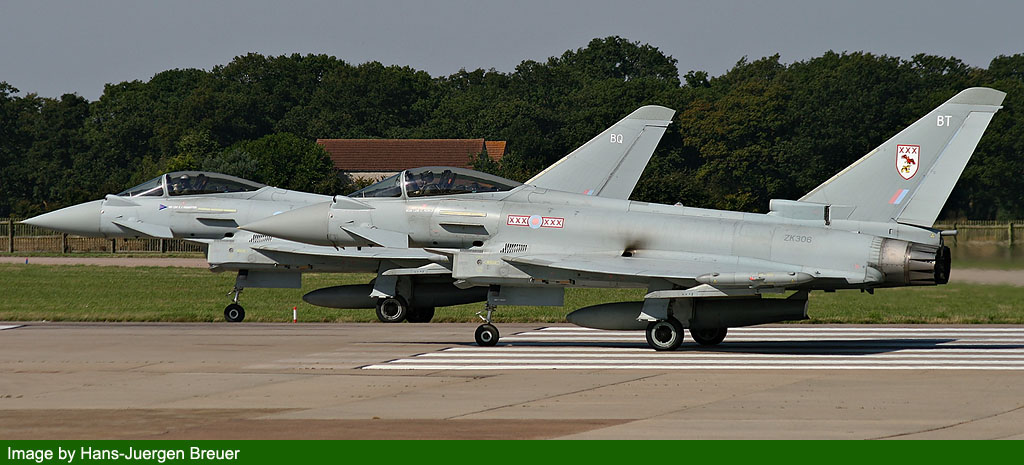 |
I preparativi dell’esercitazione Green Flag sono iniziati il 23 agosto, con gli arrivi delle aerocisterne e degli aerei per il supporto logistico, gli Airbus A 330MRTT e quattro C 130 della Royal Saudi Air Force (RSAF, l’ Aeronautica Militare dell’Arabia Saudita) rischierati nel Regno Unito rispettivamente a Brize Norton e a Coningsby. Gli A 330 sono serviti per rifornire I Tornado del No. 75 Squadron provenienti dalla base di Dhahran ed i Typhoon del No. 3 Squadron da Taif. Durante il volo di trasferimento i Typhoon hanno fatto scalo a Malta, mentre i Tornado in Italia presso la base di Grosseto, dove due di essi hanno dovuto prolungare la sosta in seguito ad un’avaria sofferta il 27 agosto. Lo stesso giorno i quattro Typhoon ed i due Tornado restanti sono arrivati a Coningsby, con i due guasti che una volta tornati in efficienza li hanno seguiti due giorni dopo.
I codici di chiamata radio utilizzati dai Typhoon sono stati “Master” da 01 a 04 mentre ai Tornado erano assegnati “Green” da 01 a 04. L’esercitazione vera e propria è iniziata il 2 settembre per chiudersi il 13 dello stesso mese. Il No.3 Squadron di Coningsby ha ospitato i Typhoon sauditi, mentre i Tornado provenienti da Dhahran sono stati ospitati dal No. 9 Squadron di Marham: da questa base prendevano parte quotidianamente alla Green Flag sei Tornado tra quelli appartenenti alla Royal Air Force (RAF, l’Aeronautica Militare del Regno Unito) e quelli appartenenti alla RSAF.
Riguardo l’esercitazione il Comandante del Distaccamento della RSAF, il Brigadier Generale Mohammed Al-Sharani ha spiegato come “Uno degli scopi dell’esercitazione è stato quello di assicurarci che il nostro personale, dagli equipaggi di volo ai crew chief, dal personale di terra ai controllori di volo fossero in grado di lavorare fianco a fianco con quello della RAF in modo tale da essere pronti in caso di operazioni reali”. Il comandante della base RAF di Coningsby, Capitano Stinger ha invece rimarcato che “durante i dieci giorni dell’esercitazione gli equipaggi della RAF e della RSAF hanno volato in una serie di missioni a difficoltà crescente, durante le quali hanno visto aumentare la conoscenza reciproca del modo di operare dell’altra Forza Aerea coinvolta, in modo tale da poter sfruttare al massimo le potenzialità dei rispettivi velivoli”. Il Capitano Stinger ha invece aggiunto che “per Coningsby e per la RAF in generale la Green Flag ha rappresentato un’occasione unica per volare con gli aerei della RSAF, gli stessi di cui anche noi disponiamo, per condividere le tattiche di impiego dei nostri assetti e per Coningsby di ospitare un rischieramento di aerei di una nazione straniera.”
E’ degno di nota ricordare inoltre come buona parte dei piloti e del personale di terra della RSAF fosse già stata a Coningsby prima dell’addestramento all’impiego del Typhoon iniziato nel 2008. |
 |
 |
 |
|
|
 |
 |
|
|
 |
 |
Foto e testo di Hans-Juergen Breuer
Settembre 2013 |
|
English translation
The first Movements for the Exercise started with Tanker and Ground-Support on 23 August with some A330 MRTT to land at Brize Norton.UK
and four C 130 from the RSAF to RAF Coningsby.
The A330 were used refuelling the Tornados from 75 SQD Dhahran and the Typhoons from No 3 SQD Taif Air Base Saudi Arabia on Route. The Typhoons stopped at Malta with the Tornados at Grosseto/Italy where 2 off them broke down August 27th.
On that Day the 4 Typhoons from Taif arrived at Coningsby with 2 Tornados from Dhahran later in the Evening leaving the broken ones behind.(They followed 2 Days later).
Call-Sign using for the Typhoon’s were "Master 01-04" with the Tornado’s using "Green 01-04" during the arrival and departure.
The Training Exercise then started for real from 2-13 September. RAF Coningsby 3 SQD hosted the Saudi Typhoon’s and No.9 SQD from RAF Marham hosting the Tornado’s from Dhahran.
There for six Tornado’s had been flown in from Marham to take part in the Exercise all operating from the Main-ASP.
Via Brigadier General Mohammed Al-Sharani the RSAF Detachment Commander said "that one very important task is to make sure that our people, from Aircrew to Engineers, to Staff, to Fighter-Control and all other people work side by side with the RAF to be ready if needed to operate together for real.
"The ten Day Exercise saw the Saudi and RAF Crews fly in a series of training flights of gradually increasing complexity, during which the Crews gained a wider knowledge of how the other Force works and also how to use the relative Strength of their Aircraft to generate greater overall effects"(Words via Gp Captain Stringer Station Commander RAF Coningsby)
Gp Cpt Stringer added also: "for Coningsby and for the RAF this is a hugely significant Exercise, an opportunity to fly the same Aircraft type with our RSAF friends, to share our tactical thinking on how we employ our platforms, and for us a station to support a Detachment at significant range from a fellow Air Force".
Several of the Saudi Pilots and Engineers have been to Coningsby before as they undertook their Typhoon training at the Lincolnshire Base from around 2008 onwards.
|
Images and text by Hans-Juergen Breuer
September 2013 |
|